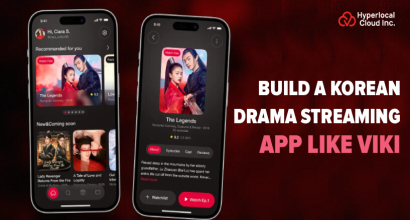The car rental industry has seen a significant shift with the rise of digital technologies and the popularity of apps like Enterprise. In the U.S., 53% of car rental customers prefer Enterprise.
The platform has fundamentally changed how a car is rented, delivering accessibility, convenience, and streamlined experiences. While the app is gaining immense popularity, another relevant chapter of developing car rental apps like Enterprise is becoming an imperative discussion for business ideas.
Developing an app like Enterprise is a cakewalk for car rental app development companies having expertise in creating apps, clones, and whitelabel platforms. However, the journey begins with a defined process that helps expand your business network.
How to Build a Car Rental App like Enterprise
Developing a car rental application like Enterprise needs professional assistance. Experts follow specific steps to create valuable car rental platforms like Enterprise. Have a look-
Step 1: Research the Market
For analysis, perform comprehensive market research on the Enterprise's app and other apps. Evaluate its functionalities, user feedback, and overall user experiences. This study will help developers build a distinctive value proposition, spot market gaps, and offer insights into practical tactics.
Step 2: Specify What You Need
Developers discuss with you which features and specifications to add to your car rental app. These essentials guide the rest of the process. For an Enterprise-like app to succeed in a crowded market, developers prefer to combine distinctive features that make them stand out with necessary features, guaranteeing a smooth user experience.
Must-have Car Rental App Features
User Registration and Profile Management
Users must create accounts and manage profile information, including payment methods. The app allows users to access their rental history, enhancing personalization and simplifying future transactions.
Rental Vehicle Availability
This feature offers a comprehensive inventory of vehicles ready for rental. Users can browse vehicle details such as make, model, year, rental rates, and images. Filtering options simplify the search process and cater to specific customer preferences.
Reservations Management
With a robust booking system, the app allows users to select rental dates, times, and locations for hassle-free reservations. Users retain flexibility with options to view, modify, or cancel bookings, ensuring they monitor their rental experience thoroughly.
Navigation Tools
Integrated GPS capabilities allow users to locate nearby rental shops and convenient pickup and drop-off points. This functionality facilitates easy access to practical rental solutions based on the user's location.
Payment Gateways
The app includes secure payment processing and safeguards the confidentiality and privacy of users' financial information. Multiple payment options are supported for enhanced convenience.
Push Notifications
Push notifications inform users about various transaction stages, including promotional offers, rental status updates, booking confirmations, and timely reminders. Care is taken to maintain relevance and avoid overwhelming users with excessive notifications.
Rating and Reviews System
The app embodies a ratings and reviews system. Users contribute to the rental car services by sharing their rental experiences, aiding others in making well-informed decisions, and cultivating a culture of high-quality service.
Step 3: Work on the Design
Developers build attractive user interfaces that improve the overall user experience. This process starts with wireframes and prototype creation, exhibiting the app's flow and design. Developers develop a straightforward and intuitive product, which is critical for consumer happiness. However, it is equally important to identify and address your target group's needs.
Step 4: Develop the MVP.
The MVP (Minimum Viable Product) allows experts to build the product with the essential features. Once it's ready, they release it to check if its main idea works and to collect feedback for future improvements. On the server side, they set up crucial parts like databases, APIs, and web services, ensuring all data and transactions are securely handled with solid security measures.
Step 5: Test Your App
After completing the car rental app development, developers emphasize testing its functionality, usability, and performance. This involves manual and automated testing to identify and fix any issues or bugs. Testing the app on various devices and operating systems ensures it works well for all users.
Step 6: Deploy and Launch
Once developers have thoroughly tested the app and made the required fixes, they launch it on platforms like Google Play, the App Store, and other app marketplaces. Follow their guidelines closely to ensure a smooth submission and approval process. Lastly, develop an effective marketing strategy to reach your target users with your mobile app.
What's next? Take your car rental business to the next level with result-oriented applications with top-notch features to engage your target customers. Contact us now!
Revenue Model of Car Rental App like Enterprise
A car rental app like Enterprise includes a revenue model that maximizes profitability while offering customer value. Here's an outline of the revenue model typically used:
Rental Fees: Rental fees, the primary source of revenue for car rental apps such as Enterprise, vary with service usage. Customers pay for the time they use the vehicle, whether an hour, daily, or weekly. Rates vary depending on the type of car (e.g., economy, luxury, SUV) and the rental duration.
Insurance and Damage Waivers: Car rental providers allow clients to pay for insurance policies and damage waivers. Insurance payments are an essential source of revenue, as they provide the most significant part of insurance companies' revenues. However, if a driver causes damage, no claim will be covered.
Fuel Charges: A common type implemented by rental companies is the "full-to-full" policy, whereby the client has to refill the fuel tank to the initial level before hiring the car and refuel it before returning to the company. If the vehicle is returned with an empty tank, the firm's filling cost might not be less than the local fuel pricing.
Membership Programs: Car rental firms use various strategies, including offering loyalty and membership schemes. These programs either have an annual fee or offer several membership levels at multiple costs, some offering lower rental rates, free upgrades, and faster services.
Penalties and Fees: Car rental companies charge fees for various reasons, such as delayed returns, cancellations, and returning the car in a substandard state and beyond acceptable usage. Such fees help the company expend the funds required to oversee fleet management and provide diligent customer service.
Benefits of Developing Car Rental Apps like Enterprise
Building a car rental app similar to Enterprise offers several benefits. Below are some key advantages:
Tap Lucrative Market: The research says the global number of users in the car rental segment will touch 644.4 million in 2028, proving a new peak. When it enters the market, an app like Enterprise can access target audiences across digital marketing channels and social media portals to enhance brand awareness.
No Cumbersome Paperwork: A car rental app like Enterprise persuades no cumbersome paperwork through digital KYC, e-contracts, and automated booking summaries. It helps users go digital and opt for your business when renting a car in a few clicks. Diminishing paperwork expenses leads to better distribution towards quality and customer satisfaction.
Convenience: When users easily browse available vehicles, choose rental options, and make reservations through the app, this convenience appeals to them for instant services. The app handles reservations, modifications, and cancellations smoothly, providing flexibility to users.
GPS Integration: Integration with GPS systems helps users locate the nearest rental branch or navigate to pick up their reserved vehicle. This feature adds value by simplifying the rental process and enhancing user experience.
Brand Visibility and Market Reach: A well-developed car rental app enhances brand visibility and expands market reach beyond physical rental locations. It allows the business to attract tech-savvy customers who prefer digital solutions.
The Final Words
Creating a vehicle rental app like Enterprise requires meticulous planning, robust development, and savvy marketing. You can design a competitive app by focusing on user-centric features, leveraging the correct technological stack, and applying efficient marketing techniques.



